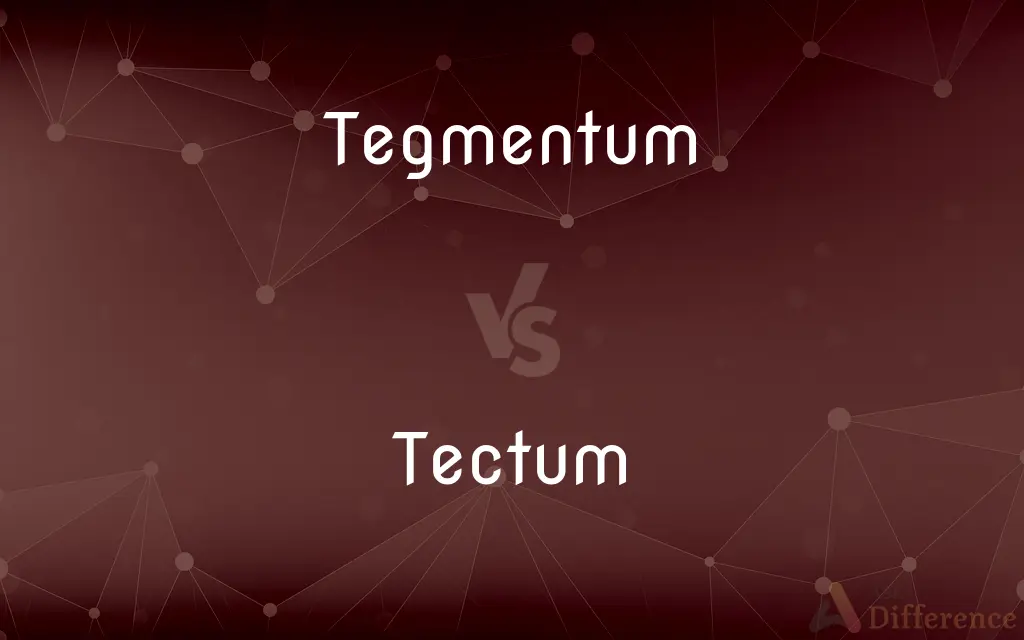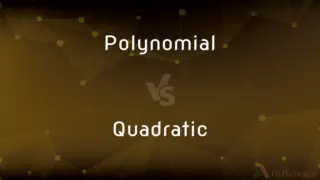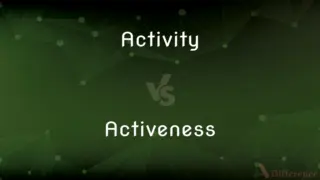Tegmentum vs. Tectum — What's the Difference?
By Maham Liaqat & Urooj Arif — Updated on April 8, 2024
The tegmentum is part of the brainstem involved in movement and arousal, while the tectum, located in the midbrain, controls visual and auditory reflexes.

Difference Between Tegmentum and Tectum
Table of Contents
ADVERTISEMENT
Key Differences
The tegmentum, situated within the brainstem, plays a crucial role in motor function, regulating movements and postural control. It contains the red nucleus and the substantia nigra, both of which are integral to the movement control system. Whereas the tectum, forming the dorsal part of the midbrain, comprises the superior and inferior colliculi, which are primarily involved in processing visual and auditory information, respectively.
The tegmentum is associated with basic bodily functions such as regulation of arousal, awareness, and certain reflex actions. It's also involved in the modulation of pain. On the other hand, the tectum is key to the orientation of the body in response to sensory stimuli, facilitating reflexive reactions to sounds and sights by directing the head and eye movements towards these stimuli.
The anatomical location of the tegmentum allows it to interact closely with various parts of the nervous system, including the reticular formation, which is essential for maintaining consciousness. The tectum, with its position at the roof of the midbrain, acts as a relay station for sensory information heading to the primary sensory areas of the cerebral cortex.
The tegmentum is involved in several pathways, including those that affect mood and reward, which links it to conditions such as Parkinson's disease and addiction. In contrast, damage to the tectum can lead to deficits in visual and auditory reflexes, indicating its critical role in sensory processing.
Despite their differences, both the tegmentum and the tectum are integral to the brain's function, with the former focusing on internal regulation and movement, and the latter on external sensory responses. Their coordinated actions are vital for the smooth execution of both voluntary and involuntary responses to internal and external stimuli.
ADVERTISEMENT
Comparison Chart
Location
Part of the brainstem.
Dorsal part of the midbrain.
Function
Involved in movement control, arousal, and pain modulation.
Processes visual and auditory stimuli, controlling reflexes.
Components
Contains red nucleus and substantia nigra.
Comprises superior and inferior colliculi.
Role in Neurology
Associated with motor functions and the modulation of mood and reward.
Essential for sensory processing and orientation reflexes.
Clinical Significance
Linked to Parkinson's disease and mood disorders.
Damage can impair sensory reflexes, affecting sight and hearing.
Compare with Definitions
Tegmentum
Regulates arousal and consciousness.
Tegmental damage leading to altered levels of awareness.
Tectum
Processes sensory information for orientation.
The tectum's function in directing gaze to moving objects.
Tegmentum
A part of the brainstem involved in motor functions.
The tegmentum's role in walking.
Tectum
The dorsal part of the midbrain. controlling visual and auditory reflexes.
Turning your head towards a sound.
Tegmentum
Contains the red nucleus and substantia nigra. critical for movement control.
Its involvement in the pathophysiology of Parkinson's disease.
Tectum
Comprises the superior and inferior colliculi.
The superior colliculus' role in visual tracking.
Tegmentum
Affects mood and reward. linking it to conditions like depression and addiction.
Tegmental pathways influencing mood regulation.
Tectum
Acts as a relay station for sensory signals.
Transmitting auditory data to the auditory cortex.
Tegmentum
Modulates pain.
The tegmentum's involvement in the pain relief process.
Tectum
Damage can lead to sensory reflex deficits.
Impaired auditory reflexes due to tectal lesions.
Tegmentum
The tegmentum (from Latin for "covering") is a general area within the brainstem. The tegmentum is the ventral part of the midbrain and the tectum is the dorsal part of the midbrain.
Tectum
A rooflike structure of the body, especially the dorsal part of the midbrain.
Tegmentum
A covering or integument of an organ or body part.
Tectum
(neuroanatomy) The dorsal portion of the midbrain of vertebrates; in mammals, containing the superior colliculus and inferior colliculus
Tegmentum
The ventral part of the midbrain.
Tectum
The interconnected outer surface of a spore.
Tegmentum
(neuroanatomy) The ventral portion of the midbrain, divided from the tectum by the cerebral aqueduct and the periaqueductal grey
Tegmentum
(neuroanatomy) Containing the following nuclei: red nucleus, substantia nigra, ventral tegmental area
Tegmentum
A covering; - applied especially to the bundles of longitudinal fibers in the upper part of the crura of the cerebrum.
Common Curiosities
What is the tegmentum?
The tegmentum is a part of the brainstem involved in regulating movement, arousal, and pain.
What happens if the tectum is damaged?
It can result in deficits in visual and auditory reflexes, impairing sensory processing.
How are the tegmentum and tectum anatomically related?
Both are located in the midbrain, with the tegmentum positioned ventrally to the tectum.
Can the functions of the tegmentum and tectum overlap?
While primarily serving different functions, both contribute to the brain's overall regulatory and sensory processing capabilities.
Why is the tectum important for sensory reflexes?
It enables quick, reflexive responses to visual and auditory stimuli, essential for survival.
How does the tectum influence auditory processing?
The inferior colliculus processes auditory signals, aiding in sound localization.
What is the tectum?
The tectum is the dorsal portion of the midbrain, responsible for processing visual and auditory stimuli.
What are the clinical implications of damage to the tegmentum?
Damage can lead to motor disorders, such as Parkinson's disease, and affect mood and awareness.
What role does the tegmentum play in pain modulation?
It contains pathways and structures that help modulate the perception and reaction to pain.
How do the tegmentum and tectum differ in function?
The tegmentum regulates motor functions and consciousness, while the tectum processes sensory information for reflex actions.
What makes the tegmentum important for motor control?
Its components, like the red nucleus and substantia nigra, are essential for initiating and regulating movements.
Are there preventive measures for tectum damage?
Preventive measures are not specific but include general brain health strategies like injury prevention and maintaining overall health.
What are some disorders associated with the tegmentum?
Parkinson's disease and mood disorders can be linked to dysfunction in tegmental areas.
How does the tectum assist in visual tracking?
The superior colliculus, part of the tectum, helps coordinate eye movements to track moving objects.
What treatments exist for tegmentum-related disorders?
Treatments may include medications for symptom management and therapies targeting motor and mood symptoms.
Share Your Discovery

Previous Comparison
Polynomial vs. Quadratic
Next Comparison
Activity vs. ActivenessAuthor Spotlight
Written by
Maham LiaqatCo-written by
Urooj ArifUrooj is a skilled content writer at Ask Difference, known for her exceptional ability to simplify complex topics into engaging and informative content. With a passion for research and a flair for clear, concise writing, she consistently delivers articles that resonate with our diverse audience.
















































